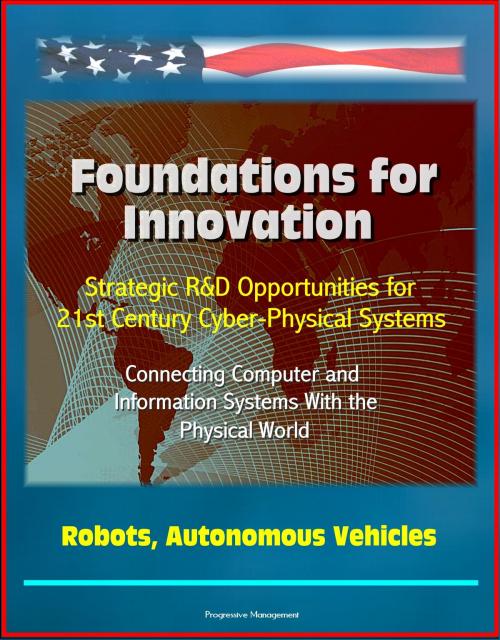Foundations for Innovation: Strategic R&D Opportunities for 21st Century Cyber-Physical Systems - Connecting Computer and Information Systems With the Physical World, Robots, Autonomous Vehicles
Nonfiction, Science & Nature, Technology, Robotics, Computers, Programming, Software Development| Author: | Progressive Management | ISBN: | 9781311365491 |
| Publisher: | Progressive Management | Publication: | February 27, 2015 |
| Imprint: | Smashwords Edition | Language: | English |
| Author: | Progressive Management |
| ISBN: | 9781311365491 |
| Publisher: | Progressive Management |
| Publication: | February 27, 2015 |
| Imprint: | Smashwords Edition |
| Language: | English |
This report is the third in a series of reports developed with input from a group of world-renowned experts in cyber-physical systems (CPS) and related technologies. Building on previous reports, this document provides a high-level perspective of the key challenges and strategic research and development opportunities for advancing CPS. The report will be used by both public and private stakeholders to inform decisions about the technology R&D that should be pursued, as well as the new measurement methods and standards that must be developed to realize the transformative potential of CPS.
The wide reach of the Internet along with rapid advances in miniaturization, speed, power, and mobility have led to the pervasive use of networking and information technologies (IT) across all economic sectors. Increasingly, these technologies are combined with elements of the physical world (e.g., machines, devices, structures) to create smart or intelligent systems that offer increased effectiveness, productivity, safety, and speed and enable functions not previously possible. Integrated networking, information processing, sensing and actuation capabilities allow physical devices to operate in changing environments. This makes smart systems possible but also creates the need for a new 'systems science' that can lead to unprecedented capabilities. Tightly coupled cyber and physical systems that exhibit this level of integrated intelligence are sometimes referred to as cyber-physical systems (CPS). All CPS have computational processes that interact with physical components. These can be relatively simple (e.g., a heater, cutting machine) or comprise multiple components in complex assemblies (e.g., vehicles, aircraft systems, oil refineries). The computational and physical processes of such systems are tightly interconnected and coordinated to work together effectively, often with humans in the loop.
INTRODUCTION * A Call to Action * Reaping the Benefits of Cyber-physical Systems * BROAD CHALLENGES FOR CYBER-PHYSICAL SYSTEMS * Scientific and Technical Challenges * Institutional, Societal, and Other Challenges * STRATEGIC R&D OPPORTUNITIES * SCIENCE AND ENGINEERING FOUNDATIONS * Opportunity * Robust, effective design and construction of systems and infrastructure * SYSTEM PERFORMANCE, QUALITY, AND ACCEPTANCE * Opportunity * Improved performance and quality assurance of computational and physical systems * SYSTEMS OF ENGINEERING * Opportunity * Effective and reliable system integration and interoperability * WORKFORCE FOR CONTINUING INNOVATION * Opportunity * Dynamic, multi-disciplinary education and training
This report is the third in a series of reports developed with input from a group of world-renowned experts in cyber-physical systems (CPS) and related technologies. Building on previous reports, this document provides a high-level perspective of the key challenges and strategic research and development opportunities for advancing CPS. The report will be used by both public and private stakeholders to inform decisions about the technology R&D that should be pursued, as well as the new measurement methods and standards that must be developed to realize the transformative potential of CPS.
The wide reach of the Internet along with rapid advances in miniaturization, speed, power, and mobility have led to the pervasive use of networking and information technologies (IT) across all economic sectors. Increasingly, these technologies are combined with elements of the physical world (e.g., machines, devices, structures) to create smart or intelligent systems that offer increased effectiveness, productivity, safety, and speed and enable functions not previously possible. Integrated networking, information processing, sensing and actuation capabilities allow physical devices to operate in changing environments. This makes smart systems possible but also creates the need for a new 'systems science' that can lead to unprecedented capabilities. Tightly coupled cyber and physical systems that exhibit this level of integrated intelligence are sometimes referred to as cyber-physical systems (CPS). All CPS have computational processes that interact with physical components. These can be relatively simple (e.g., a heater, cutting machine) or comprise multiple components in complex assemblies (e.g., vehicles, aircraft systems, oil refineries). The computational and physical processes of such systems are tightly interconnected and coordinated to work together effectively, often with humans in the loop.
INTRODUCTION * A Call to Action * Reaping the Benefits of Cyber-physical Systems * BROAD CHALLENGES FOR CYBER-PHYSICAL SYSTEMS * Scientific and Technical Challenges * Institutional, Societal, and Other Challenges * STRATEGIC R&D OPPORTUNITIES * SCIENCE AND ENGINEERING FOUNDATIONS * Opportunity * Robust, effective design and construction of systems and infrastructure * SYSTEM PERFORMANCE, QUALITY, AND ACCEPTANCE * Opportunity * Improved performance and quality assurance of computational and physical systems * SYSTEMS OF ENGINEERING * Opportunity * Effective and reliable system integration and interoperability * WORKFORCE FOR CONTINUING INNOVATION * Opportunity * Dynamic, multi-disciplinary education and training















